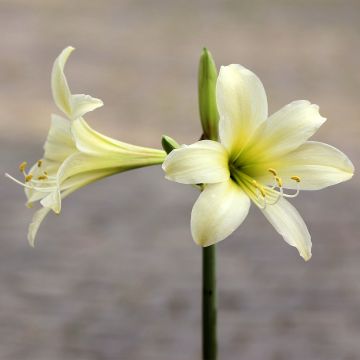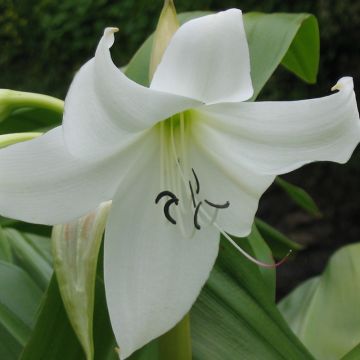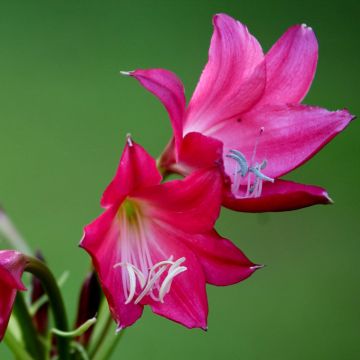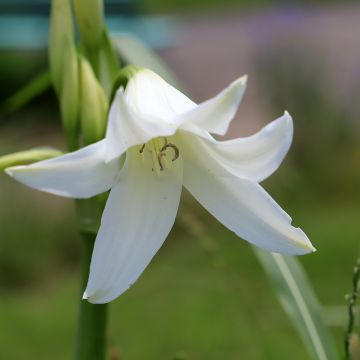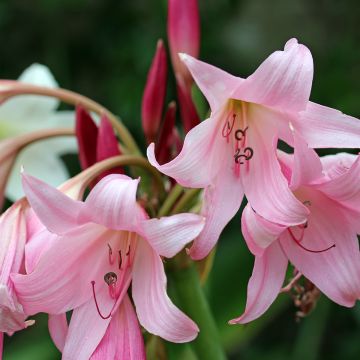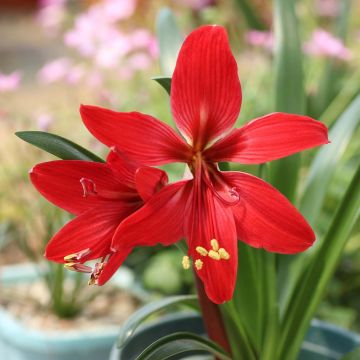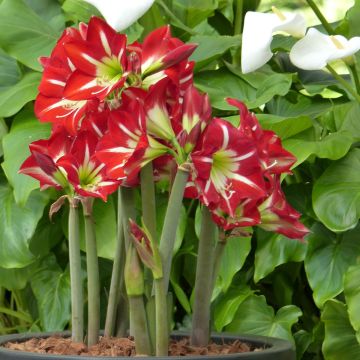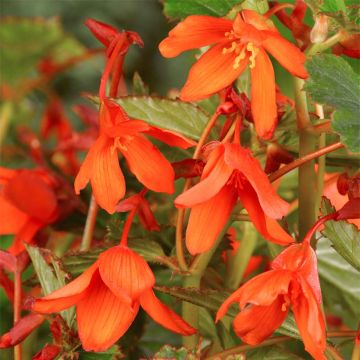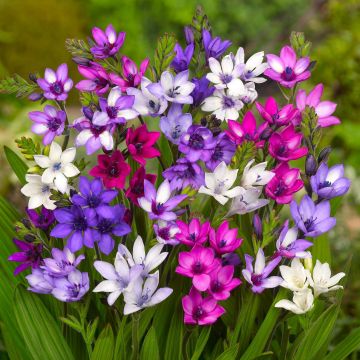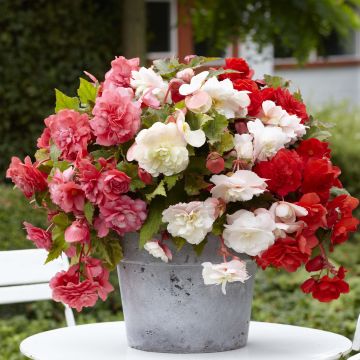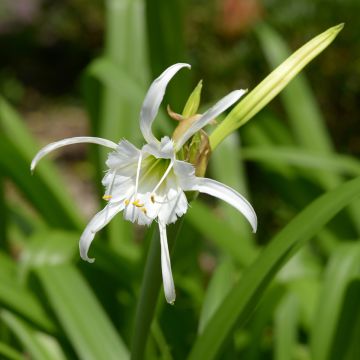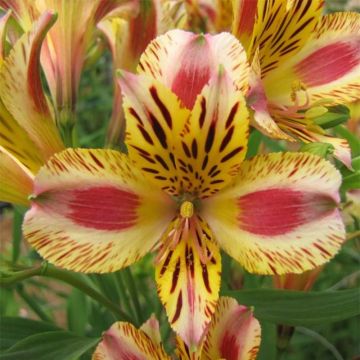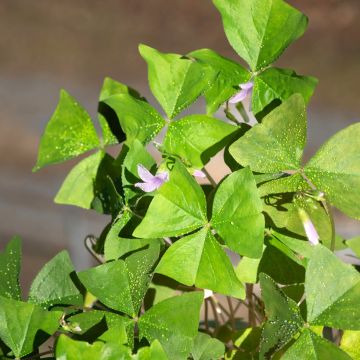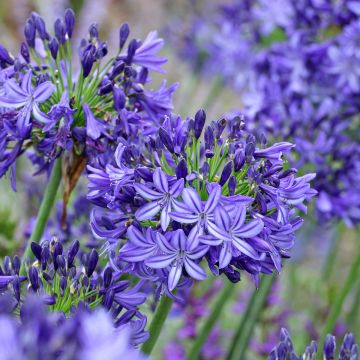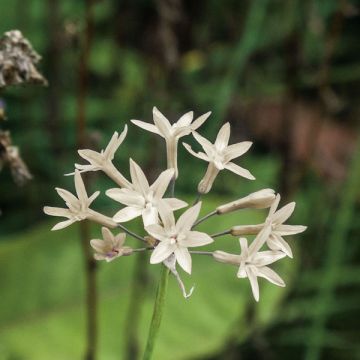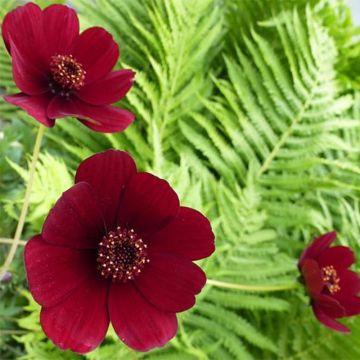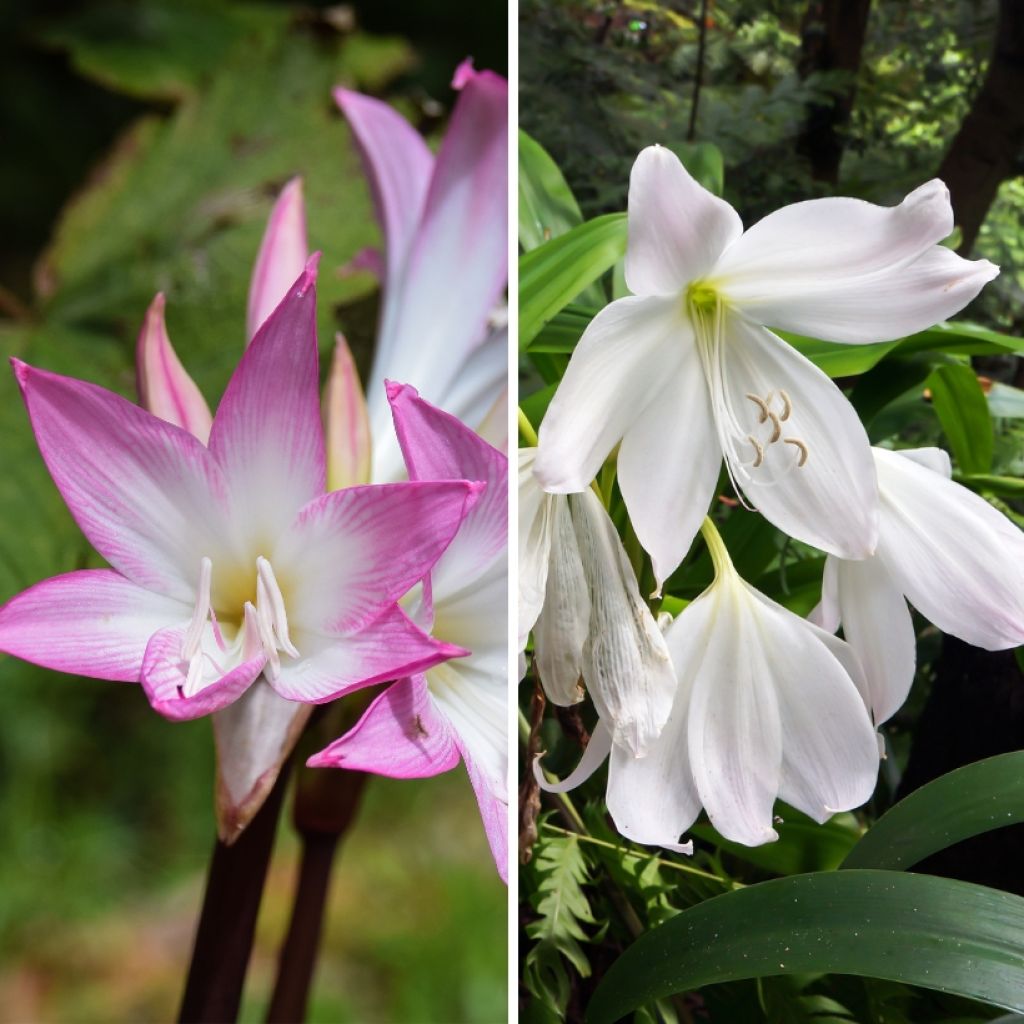

Duo of Amaryllis belladonna - Jersey Lily
Duo of Amaryllis belladonna - Jersey Lily
Amaryllis belladonna
Belladonna Lily, Jersey Lily
This item cannot be shipped to the selected country
Delivery charge from €5.90
More information
Schedule delivery date,
and select date in basket
This plant carries a 6 months recovery warranty
More information
We guarantee the quality of our plants for a full growing cycle, and will replace at our expense any plant that fails to recover under normal climatic and planting conditions.
From €5.90 for pickup delivery and €6.90 for home delivery
Express home delivery from €8.90.
Does this plant fit my garden?
Set up your Plantfit profile →
Collection items (2 plants)
Description
A duo of Amaryllis belladonna or Belladonna Lily, composed of the classic variety with pink flowers and its 'Alba' form. These perennial bulbous plants bloom between late August and early October depending on the climate, on sturdy stems that reach a height of 50 to 60 cm (20 to 24in). The ribbon-like foliage, reminiscent of agapanthus, emerges from the ground in autumn and disappears at the end of spring, before the arrival of summer drought. In the garden, these amaryllis bulbs are planted in flower beds or sunny borders. In our very cold or very humid regions in summer, pot cultivation is essential.
The duo consists of:
1 x Amaryllis belladonna: the species with pink flowers, slightly fragrant.
1 x Amaryllis belladonna 'Alba': an elegant variant of Amaryllis belladonna, characterized by its pure white, luminous flowers, offering an interesting contrast with the classic variety.
Plant Amaryllis belladonna and its 'Alba' variety in a sunny flower bed or border, in well-drained soil, preferably dry in summer. The bulbs can also be planted between the stones of a rockery or in pots. Space them 30 to 35 cm (12 to 14in) apart to allow for optimal development. Excess moisture is harmful in summer, as it can cause bulb rot during their dormant period.
Plant Amaryllis belladonna bulbs among other low-growing plants with similar needs that will conceal their absence in summer. Lavender Hidcote , with its deep blue-violet flowers, forms an interesting contrast with their trumpet-shaped pink and white flowers. Woodland Sage Caradonna adds verticality to the scene with its dark purple flower spikes. To play with textures and shapes, opt for Santolina chamaecyparissus, a large cushion of silver foliage.
Report an error about the product description
Plant habit
Flowering
Foliage
Botanical data
Amaryllis
belladonna
Amaryllidaceae
Belladonna Lily, Jersey Lily
South Africa
Other Amaryllis and Crinums
Planting and care
Cultivation in open ground is possible in regions where winter is not too harsh and summer is rather dry to very dry. Summer rain is not favourable to the bulb, which can rot during its resting period. Likewise, summer drought induces flowering in the following season. Amaryllis belladonna is planted in a very hot exposure, in soft, light, well-drained soil. Limestone is tolerated, but it will appreciate a generous supply of compost. Plant them at a depth of 15 to 20 cm (6 to 8in), spaced 25 to 30 cm (10 to 12in) apart. It will need a sheltered location and protection from frost with mulch or a layer of dry leaves. Well protected, the bulb can withstand very short frosts of around -10 °C (14°F).
The bulb is preferably planted during the resting period, between July and August.
Planting period
Intended location
Care
This item has not been reviewed yet - be the first to leave a review about it.
Bulbs to grow in pots
Haven't found what you were looking for?
Hardiness is the lowest winter temperature a plant can endure without suffering serious damage or even dying. However, hardiness is affected by location (a sheltered area, such as a patio), protection (winter cover) and soil type (hardiness is improved by well-drained soil).

Photo Sharing Terms & Conditions
In order to encourage gardeners to interact and share their experiences, Promesse de fleurs offers various media enabling content to be uploaded onto its Site - in particular via the ‘Photo sharing’ module.
The User agrees to refrain from:
- Posting any content that is illegal, prejudicial, insulting, racist, inciteful to hatred, revisionist, contrary to public decency, that infringes on privacy or on the privacy rights of third parties, in particular the publicity rights of persons and goods, intellectual property rights, or the right to privacy.
- Submitting content on behalf of a third party;
- Impersonate the identity of a third party and/or publish any personal information about a third party;
In general, the User undertakes to refrain from any unethical behaviour.
All Content (in particular text, comments, files, images, photos, videos, creative works, etc.), which may be subject to property or intellectual property rights, image or other private rights, shall remain the property of the User, subject to the limited rights granted by the terms of the licence granted by Promesse de fleurs as stated below. Users are at liberty to publish or not to publish such Content on the Site, notably via the ‘Photo Sharing’ facility, and accept that this Content shall be made public and freely accessible, notably on the Internet.
Users further acknowledge, undertake to have ,and guarantee that they hold all necessary rights and permissions to publish such material on the Site, in particular with regard to the legislation in force pertaining to any privacy, property, intellectual property, image, or contractual rights, or rights of any other nature. By publishing such Content on the Site, Users acknowledge accepting full liability as publishers of the Content within the meaning of the law, and grant Promesse de fleurs, free of charge, an inclusive, worldwide licence for the said Content for the entire duration of its publication, including all reproduction, representation, up/downloading, displaying, performing, transmission, and storage rights.
Users also grant permission for their name to be linked to the Content and accept that this link may not always be made available.
By engaging in posting material, Users consent to their Content becoming automatically accessible on the Internet, in particular on other sites and/or blogs and/or web pages of the Promesse de fleurs site, including in particular social pages and the Promesse de fleurs catalogue.
Users may secure the removal of entrusted content free of charge by issuing a simple request via our contact form.
The flowering period indicated on our website applies to countries and regions located in USDA zone 8 (France, the United Kingdom, Ireland, the Netherlands, etc.)
It will vary according to where you live:
- In zones 9 to 10 (Italy, Spain, Greece, etc.), flowering will occur about 2 to 4 weeks earlier.
- In zones 6 to 7 (Germany, Poland, Slovenia, and lower mountainous regions), flowering will be delayed by 2 to 3 weeks.
- In zone 5 (Central Europe, Scandinavia), blooming will be delayed by 3 to 5 weeks.
In temperate climates, pruning of spring-flowering shrubs (forsythia, spireas, etc.) should be done just after flowering.
Pruning of summer-flowering shrubs (Indian Lilac, Perovskia, etc.) can be done in winter or spring.
In cold regions as well as with frost-sensitive plants, avoid pruning too early when severe frosts may still occur.
The planting period indicated on our website applies to countries and regions located in USDA zone 8 (France, United Kingdom, Ireland, Netherlands).
It will vary according to where you live:
- In Mediterranean zones (Marseille, Madrid, Milan, etc.), autumn and winter are the best planting periods.
- In continental zones (Strasbourg, Munich, Vienna, etc.), delay planting by 2 to 3 weeks in spring and bring it forward by 2 to 4 weeks in autumn.
- In mountainous regions (the Alps, Pyrenees, Carpathians, etc.), it is best to plant in late spring (May-June) or late summer (August-September).
The harvesting period indicated on our website applies to countries and regions in USDA zone 8 (France, England, Ireland, the Netherlands).
In colder areas (Scandinavia, Poland, Austria...) fruit and vegetable harvests are likely to be delayed by 3-4 weeks.
In warmer areas (Italy, Spain, Greece, etc.), harvesting will probably take place earlier, depending on weather conditions.
The sowing periods indicated on our website apply to countries and regions within USDA Zone 8 (France, UK, Ireland, Netherlands).
In colder areas (Scandinavia, Poland, Austria...), delay any outdoor sowing by 3-4 weeks, or sow under glass.
In warmer climes (Italy, Spain, Greece, etc.), bring outdoor sowing forward by a few weeks.




































